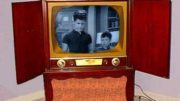I picked up the Digiair Pro ATSC Signal Analyzer, made in Sweden, sold in various places but also at SolidSignal.com. See: Solid Signal Digiair Pro ATSC Spectrum Analyzer (DIGIAIR-PRO-ATSC) from Solid Signal sku=700112818462
I first unboxed the analyzer and installed the last battery. I like the fact that this analyzer uses eight Ni-MH batteries. The ones shipped with the unit are 1200 mAh, so if you want to go first class, pick up the “SANYO eneloop 1,900 mAh Ni-MH minimum…” which “maintain 75 percent of their charge after three years of storage” and “can be recharged up to 1,500 times.” See: SANYO :: eneloop Rechargeable Batteries :: AA 8-Pack.
If you don’t need the long shelf life you can get less expensive Ni-MH batteries. I’ve seen them up to 2500 mAh (or as I like to say 2.5 Ah) which would more than double the two-hour operating time of the analyzer from the internal batteries supplied. I have not run a continuous test of the unit with these batteries, but in two consecutive days I ran the unit for about 30 minutes the first day and less than 15 minutes the second day. The batteries were down to ¼ the full charge of just two days ago, which was very disappointing.
The first thing I did was to connect a small fractal TV antenna I built. (See the article at Fractal Magic DIY HDTV Antenna – Viewing Comments 1-40) I turned the analyzer on and it came up in the analog signal level display of a single channel. I then took a little time to go through all the channels to see what it measured.
First, if you use this device, you need to know that it shows the actual channel numbers, NOT the USA phony-balony channel numbers (the station ID numbers) and you’ll need to have a conversion chart for your area to know which station IDs go along with the real channel numbers. To do this, go to any of the online Over-The-Air TV predictive sites to see which stations you should be able to receive. Most of these should give not only the station ID numbers, but also the corresponding real channel number (the number associated with the frequencies in use for that channel). I like to start out looking at TV Fool and just enter my zip code for an overview of available stations. This site now allows one to enter GPS coordinates so you can get really precise information. NOTE: TVFool is overly optimistic about how many stations you will be able to receive but the really nice thing about TVFool is that it lists every station you have any chance of receiving even if you have to use an extremely high-gain antenna up at 100 feet to do it.
I haven’t yet associated signal levels with viewable stations but I have noticed that the unit’s analog signal-level meter bottoms out at 30 dBuV. This indicates that the manufacturer does not consider anything lower than 30 dBuV worth bothering with. During some brief tests I was able to get at least one station at around 27 dBuV with my little portable DTV. Your mileage may vary since not all DTV tuners are made equally. I did this by adding attenuators and I noticed that when I added a 3dB attenuator, the meter showed a corresponding 3dBuV drop in signal level. I continued on below 30 dBuV and had to get to around 24 dBuV before the final station was lost completely. There was one station being tested that was lost around 37 dBuV and then it would come back and be “G” (good) at the same level. Another interesting piece of information is that both the BER and the SNR went missing at times below 40 dBuV which makes analyzing the signal impossible since we’re only left with the analog signal level. NOTE: I did not run a good statistical sampling and analysis, only a few tests, but all drops indicated by the meter were within +/- 1 dB of the value of the attenuator added so I am rather confident that the final numbers are close to +/- 1 dB of what the meter would indicate if it went down to 24 dBuV.
This analyzer is good, it shows the signal levels for channels 7 and 11 from Washington, D.C. (these happen to be the station IDs and the actual channel numbers), neither of which can be reliably received by any TV using any of my antennas. I have not yet looked at the BER or S/N for these stations.
After this quick check, I went to my installed Porcupine (Quad-Element Turnstile Bow Tie) Antenna and did the same thing. Then I pushed the mode button and found all the other displays: BER, S/N, MER, Spectrum Display, and multiple channel display, six channels per “page” (there are five pages).
Another note: there are no decimal channel numbers. This analyzer is looking at the 6 MHz bandwidth of the station’s transmission. It does not divide that up into sub-programs carried on the transmission. One can assume that if this analyzer shows a given signal level for channel 48 (our Washington, D.C. station ID CH 2), it applies to all programs within that bandwidth – so 2.1, 2.2, 2.3, etc., if they exist.
This antenna picked up far more stations than the little Fractal antenna sitting in my basement office window because the Porcupine is up about 20 feet above our roof. I then looked at the BER and SNR (or S/R) for the strongest stations and found both the BERs and SNRs were very good as well, as expected.
There is a note in the user’s manual that says that the analog signal level corresponds to the BER and S/N ratio but that it will not always represent the best reception and one may need to adjust the antenna direction based on the BER & S/N after first setting it using the analog signal level.
Measurements of interest are the stations the analyzer can see but the TV cannot, such as our channels 7 and 11, which are from Washington, D.C. Trying to optimize the signal from these stations might help being able to receive them.
The last thing I did with the analyzer was to find out the approximate values for the analog signal level, Bit Error Rate (BER), and the Signal to Noise Ratio (SNR or S/R), which corresponded to the point at which the signal changes from good to poor, viewable to pixelating, and not really viewable. With this rough information, we should be able to evaluate a given antenna installation for usability. Knowing that an installation is marginal will give the needed information that the installation needs to be improved before it will perform well in all sorts of weather conditions. Another thing to find out is how the weather actually affects the signal levels, BER, and SNR. This will be done as time and weather permits.
The test performed was to view a good signal, read the signal level, BER, and SNR, and then add enough attenuation to cause the signal to start pixelating, and then more attenuation to cause a loss of the signal completely and then read/record the values again.
The biggest problem I see with digital over-the-air TV is that even a really good signal on a good day can drop out completely on a bad weather day. I’ve experienced this with the stations from Baltimore which should be “perfect” and yet, during a very weak remnant of a hurricane, we had to constantly switch stations in order to get the news about the weather since each station would drop out or simply be unwatchable at different times during the storm. None of the basic three (NBC, CBS, or ABC) were able to reliably reach us during this storm.
The set-up was adding 25 feet of coax to the antenna port from the Porcupine antenna on the roof above the kitchen. The coax went to a 2-way splitter and each output has -3.5 dB of the initial signal. One port was connected to the little portable TV and the other to the analyzer. I selected channel 13 since it was now down to ~50 dBuV and the TV had a good picture and sound. (NOTE: The analyzer’s analog signal level meter measures from 30 – 60 dBuV and then an internal attenuator can be added to allow it to read above 60 dBuV.)
At this point I stopped and recharged the batteries since they were already only half full. I don’t know how much time the unit was on with my running the initial test but after the recharge and then 30 minutes of operation the analyzer was at 12/14 pixels, about 85% of full charge if the indicator is linear. NOTE: I don’t yet know if these batteries are really lasting a full 2 hours. I feel as though they are not lasting anywhere near that long, but it could simply be that time flies while I’m having so much fun using the thing.
Viewability:
L: Lost – TV doesn’t find anything
B: Bad – TV has pixels and spotty sound, not worth watching
P: Poor – TV has picture and audio that is mostly viewable/understandable but is constantly pixelating.
G: Good – TV has picture and audio worth watching
All signals started at -3.5 dB since I was using a splitter to the TV and to the analyzer. This is the test’s Zero point, or the best the signal will ever be. Attenuators were added to see at which level the picture and sound became marginal, “P” (poor), and when they are “L” (lost).
Signal (Atten: dB, Level: dBuV)
|
Atten
|
RCh | Level | BER | SNR | Viewability | Comments |
|
0
|
13
|
~57
|
0
|
26
|
G
|
|
|
18
|
13
|
~37
|
0.16
|
18
|
B – L
|
|
|
18
|
13
|
~37
|
0.16
|
18
|
G
|
(just a few minutes later) |
|
——-
|
——-
|
——-
|
——
|
——
|
————–
|
——————————- |
|
18
|
11
|
>37
|
0
|
18
|
G
|
|
|
24
|
11
|
32
|
NA
|
NA
|
G
|
|
|
——-
|
——-
|
——-
|
——
|
——
|
————–
|
——————————- |
|
0
|
29
|
>45
|
0
|
21
|
G
|
|
|
6
|
29
|
~40
|
0
|
18
|
G
|
|
|
12
|
29
|
>33
|
0
|
18
|
G
|
|
|
18
|
29
|
>30
|
NA
|
NA
|
G
|
(>30 = 30.1 – 30.5) |
|
21
|
29
|
30
|
NA
|
NA
|
B – L
|
(~27 dBuV) |
|
24
|
29
|
30
|
NA
|
NA
|
L
|
(~24 dBuV) |
The analyzer only goes down to 30 dBuV. Since the analyzer and the use of the attenuators was pretty much in sync, it seems one can assume that the signal levels decreased by the added attenuation +/- ~ 1dBuV.
The Future: I do plan on testing the battery life as well as the changes to the signal level, BER, and SNR during inclement weather. When I have these results I’ll post them here as comments.
08/17: While I was running some antenna tests I started the Digair with a freshly charged set of batteries. After the first hour the charge was down to two pixels or something less than 20% of full charge. At this point I plugged the unit into the 12 V battery I had brought along. This was only half the advertised life of the batteries so either the unit I have takes more current, or the batteries are not up to their mAh ratings, or the claimed running time with the supplied batteries is overly optimistic, to put it mildly.
In the meantime…
Good-Watching!
Philk





